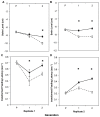The quantitative genetic architecture of the bold-shy continuum in zebrafish, Danio rerio
- PMID: 23840902
- PMCID: PMC3698077
- DOI: 10.1371/journal.pone.0068828
The quantitative genetic architecture of the bold-shy continuum in zebrafish, Danio rerio
Abstract
In studies of consistent individual differences (personality) along the bold-shy continuum, a pattern of behavioral correlations frequently emerges: individuals towards the bold end of the continuum are more likely to utilize risky habitat, approach potential predators, and feed under risky conditions. Here, we address the hypothesis that observed phenotypic correlations among component behaviors of the bold-shy continuum are a result of underlying genetic correlations (quantitative genetic architecture). We used a replicated three-generation pedigree of zebrafish (Danio rerio) to study three putative components of the bold-shy continuum: horizontal position, swim level, and feeding latency. We detected significant narrow-sense heritabilities as well as significant genetic and phenotypic correlations among all three behaviors, such that fish selected for swimming at the front of the tank swam closer to the observer, swam higher in the water column, and fed more quickly than fish selected for swimming at the back of the tank. Further, the lines varied in their initial open field behavior (swim level and activity level). The quantitative genetic architecture of the bold-shy continuum indicates that the multivariate behavioral phenotype characteristic of a "bold" personality type may be a result of correlated evolution via underlying genetic correlations.
Conflict of interest statement
Figures



Similar articles
-
Is behavioral variation along the bold-shy continuum associated with variation in the stress axis in zebrafish?Physiol Biochem Zool. 2012 Nov-Dec;85(6):718-28. doi: 10.1086/668203. Epub 2012 Oct 11. Physiol Biochem Zool. 2012. PMID: 23099468
-
Bold zebrafish (Danio rerio) learn faster in a classical associative learning task.Sci Rep. 2025 May 10;15(1):16331. doi: 10.1038/s41598-025-00423-6. Sci Rep. 2025. PMID: 40348810 Free PMC article.
-
Individual differences in response to alcohol exposure in zebrafish (Danio rerio).PLoS One. 2018 Jun 7;13(6):e0198856. doi: 10.1371/journal.pone.0198856. eCollection 2018. PLoS One. 2018. PMID: 29879208 Free PMC article.
-
Beyond bold versus shy: Zebrafish exploratory behavior falls into several behavioral clusters and is influenced by strain and sex.Biol Open. 2022 Aug 15;11(8):bio059443. doi: 10.1242/bio.059443. Epub 2022 Aug 30. Biol Open. 2022. PMID: 36039864 Free PMC article.
-
Behavioural biology: fortune favours bold and shy personalities.Curr Biol. 2004 Jun 22;14(12):R470-2. doi: 10.1016/j.cub.2004.06.011. Curr Biol. 2004. PMID: 15203018 Review.
Cited by
-
Repeatability and reliability of exploratory behavior in proactive and reactive zebrafish, Danio rerio.Sci Rep. 2018 Aug 14;8(1):12114. doi: 10.1038/s41598-018-30630-3. Sci Rep. 2018. PMID: 30108258 Free PMC article.
-
Zebrafish as an emerging model for studying complex brain disorders.Trends Pharmacol Sci. 2014 Feb;35(2):63-75. doi: 10.1016/j.tips.2013.12.002. Epub 2014 Jan 9. Trends Pharmacol Sci. 2014. PMID: 24412421 Free PMC article. Review.
-
Anxiolytic effects of fluoxetine and nicotine exposure on exploratory behavior in zebrafish.PeerJ. 2016 Aug 24;4:e2352. doi: 10.7717/peerj.2352. eCollection 2016. PeerJ. 2016. PMID: 27635325 Free PMC article.
-
Individual differences in activity levels in zebrafish (Danio rerio).Behav Brain Res. 2013 Nov 15;257:224-9. doi: 10.1016/j.bbr.2013.09.040. Epub 2013 Sep 29. Behav Brain Res. 2013. PMID: 24084583 Free PMC article.
-
Evolutionary genetics of personality in the Trinidadian guppy I: maternal and additive genetic effects across ontogeny.Heredity (Edinb). 2019 Jan;122(1):1-14. doi: 10.1038/s41437-018-0082-1. Epub 2018 May 17. Heredity (Edinb). 2019. PMID: 29773896 Free PMC article.
References
-
- Réale D, Reader SM, Sol D, McDougall PT, Dingemanse NJ (2007) Integrating animal temperament within ecology and evolution. Biol Rev 82: 291–318. doi:10.1111/j.1469-185X.2007.00010.x. PubMed: 17437562. - DOI - PubMed
-
- Wilson DS, Clark AB, Coleman K, Dearstyne T (1994) Shyness and boldness in humans and other animals. Trends Ecol Evol 9: 442–446. doi:10.1016/0169-5347(94)90134-1. PubMed: 21236920. - DOI - PubMed
-
- Conrad JL, Weinersmith KL, Brodin T, Saltz JB, Sih A (2011) Behavioural syndromes in fishes: a review with implications for ecology and fisheries management. J Fish Biol 78: 395–435. doi:10.1111/j.1095-8649.2010.02874.x. PubMed: 21284626. - DOI - PubMed
-
- Sih A, Bell AM, Johnson JC, Ziemba RE (2004) Behavioral syndromes: an integrative overiew. Q Rev Biol 79: 241–277. doi:10.1086/422893. PubMed: 15529965. - DOI - PubMed
-
- Schluter D (1996) Adaptive radiation along genetic lines of least resistance. Evolution: 1766–1774. - PubMed
Publication types
MeSH terms
Grants and funding
LinkOut - more resources
Full Text Sources
Other Literature Sources

